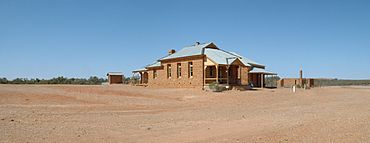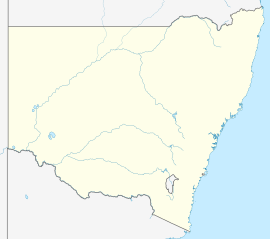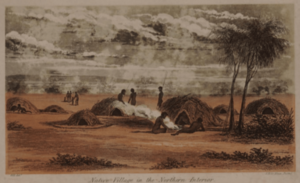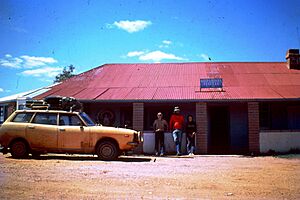Milparinka, New South Wales facts for kids
Quick facts for kids MilparinkaNew South Wales |
|||||||||
|---|---|---|---|---|---|---|---|---|---|

Historic buildings at Milparinka
|
|||||||||
| Population | 77 (2016 census) | ||||||||
| Established | 1880 | ||||||||
| Location |
|
||||||||
| LGA(s) | Unincorporated Far West Region | ||||||||
| County | Evelyn | ||||||||
| State electorate(s) | Barwon | ||||||||
| Federal Division(s) | Parkes | ||||||||
|
|||||||||
Milparinka is a small town in the far north-west of New South Wales, Australia. It's about 250 kilometers (155 miles) north of Broken Hill along the Silver City Highway. In 2016, only 77 people lived there. Milparinka is located near Evelyn Creek. Summers in Milparinka can get very hot, with temperatures reaching up to 48 degrees Celsius (118 degrees Fahrenheit).
Contents
Milparinka's Past: A Glimpse into History
Early Life in Milparinka
Long ago, Indigenous Australians were the first people to live in the Milparinka area. They built small villages with large huts. These huts were made by bending young trees and securing them to the ground. Then, branches, grass, and clay were used to create the walls and roof.
Around March each year, these communities would gather and process different local grasses. They would collect the seeds to make a type of flour for food. Large piles of harvested grass, like haystacks, were common sights.
In 1844, explorer Charles Sturt and his team faced a tough time. They were stuck for six months at nearby Preservation Creek. This happened because they ran out of supplies.
The Gold Rush Era in Milparinka
In 1880, something exciting happened. A local Indigenous woman showed a gold prospector named James Evans some gold nuggets. These nuggets were just lying on the ground at Mt Browne! Evans quickly found 24 ounces of gold. This discovery led to a huge gold rush in the area.
At its busiest, the Mt Browne goldfield had about 3,000 miners, mostly men. In January 1881, W.H.J. Slee was appointed as the Goldfields Warden. This meant he was in charge of the goldfield.
Coaches from Cobb & Co traveled three times a week from Milparinka to Wilcannia. Wilcannia, on the Darling River, was the closest town at the time, as Broken Hill didn't exist yet. By August 1881, official gold escorts had carried about 10,000 ounces of gold from the field. Even more gold was transported privately!
Challenges of Gold Mining in the Desert
This region is very dry, so water was extremely hard to find. Miners had to use a method called dry blowing to find gold. This meant they used air to separate the gold from the dirt, instead of water. Water was so precious that it sold for one shilling per bucket. Many people also got sick with dysentery because of the lack of clean water.
To help, the New South Wales government approved drilling a well in September 1881. This was suggested by W.H.J. Slee. In December 1881, the government well finally hit water at 140 feet deep. This brought great relief to everyone in the town.
Milparinka's Growth and Decline
At its peak, Milparinka was a busy town. It had its own newspaper, a police office, and a chemist shop. There were also two butchers, a courthouse (built in 1886), a school (opened in 1883), and a hospital (built in 1889). The town even had four hotels!
However, the area faced a severe drought in 1884. This made life very difficult. In June 1902, a large meteorite landed near Mt Browne, adding another interesting event to the town's history.
Milparinka's Special Places
The old buildings and areas of the Albert Goldfield are very important. They are listed on the New South Wales State Heritage Register. This means they are protected because of their historical value.




